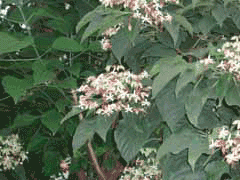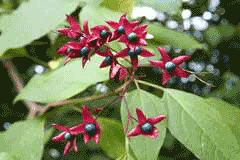 |
|
http://commons.wikimedia.org/wiki/User:Fanghong |
 |
| http://commons.wikimedia.org/wiki/User:Jean-Pol_GRANDMONT |
Translate this page:
Summary
Bloom Color: Red. Main Bloom Time: Early summer, Late summer, Mid summer. Form: Rounded, Upright or erect.
Physical Characteristics

 Clerodendrum trichotomum is a deciduous Tree growing to 6 m (19ft) by 3 m (9ft) at a medium rate.
Clerodendrum trichotomum is a deciduous Tree growing to 6 m (19ft) by 3 m (9ft) at a medium rate.
See above for USDA hardiness. It is hardy to UK zone 7. It is in flower from August to October. The species is hermaphrodite (has both male and female organs) and is pollinated by Insects.
Suitable for: light (sandy), medium (loamy) and heavy (clay) soils. Suitable pH: mildly acid, neutral and basic (mildly alkaline) soils. It cannot grow in the shade. It prefers moist soil.
UK Hardiness Map
US Hardiness Map
Synonyms
Plant Habitats
Woodland Garden Sunny Edge; Dappled Shade;
Edible Uses
Edible Parts: Leaves
Edible Uses:
Young sprouts and leaves - cooked[105, 177].
References More on Edible Uses
Medicinal Uses
Plants For A Future can not take any responsibility for any adverse effects from the use of plants. Always seek advice from a professional before using a plant medicinally.
Analgesic Antipruritic Antirheumatic Hypotensive Parasiticide Sedative
The leaves are mildly analgesic, antipruritic, hypotensive and sedative[176, 218, 254]. They are used externally in the treatment of dermatitis and internally for the treatment of hypertension, rheumatoid arthritis, joint pain, numbness and paralysis[176, 218, 254]. When used in a clinical trial of 171 people, the blood pressure of 81% of the people dropped significantly - this effect was reversed when the treatment was stopped[254]. The plant is normally used in conjunction with Bidens bipinnata[218]. When used with the herb Siegesbeckia pubescens it is anti-inflammatory[254]. The roots and leaves are antirheumatic and hypotensive[147]. A decoction is used in the treatment of rheumatoid arthritis and hypertension[147]. The pounded seed is used to kill lice[218].
References More on Medicinal Uses
The Bookshop: Edible Plant Books
Our Latest books on Perennial Plants For Food Forests and Permaculture Gardens in paperback or digital formats.

Edible Tropical Plants
Food Forest Plants for Hotter Conditions: 250+ Plants For Tropical Food Forests & Permaculture Gardens.
More

Edible Temperate Plants
Plants for Your Food Forest: 500 Plants for Temperate Food Forests & Permaculture Gardens.
More

More Books
PFAF have eight books available in paperback and digital formats. Browse the shop for more information.
Shop Now
Other Uses
References More on Other Uses
Cultivation details
Landscape Uses:Espalier, Standard, Specimen. Succeeds in a sunny position in ordinary garden soil but prefers a fertile humus-rich well-drained loam[164, 200]. The soil must not be allowed to dry out in the growing season[1]. Requires a position sheltered from cold drying winds[1, 200]. Plants are generally hardy to about -15°c[184, 200], they succeed outdoors at Kew though the branches are pithy and are apt to die back in winter[11]. The sub-species C. trichotomum fargesii. (Dode.)Rehder. is somewhat hardier, tolerating temperatures down to about -20°c[184]. Plants produce the occasional sucker[182]. The leaves have a heavy unpleasant odour when crushed[11, 182]. Flowers are produced on the current seasons growth and are sweetly scented[200]. Special Features:Not North American native, Attractive flowers or blooms.
References Carbon Farming Information and Carbon Sequestration Information
Temperature Converter
Type a value in the Celsius field to convert the value to Fahrenheit:
Fahrenheit:
The PFAF Bookshop
Plants For A Future have a number of books available in paperback and digital form. Book titles include Edible Plants, Edible Perennials, Edible Trees,Edible Shrubs, Woodland Gardening, and Temperate Food Forest Plants. Our new book is Food Forest Plants For Hotter Conditions (Tropical and Sub-Tropical).
Shop Now
Plant Propagation
Seed - best sown as soon as possible in a greenhouse. Germination can be erratic but usually takes place within 20 - 60 days at 20°c[164]. When large enough to handle, prick the seedlings out into individual pots and grow them on in the greenhouse for at least their first winter. Plant them out in late spring or early summer after the last expected frosts. Root cuttings, 6 - 8cm long, December in a greenhouse. High percentage[78]. Division of suckers in the dormant season. Very easy, they can be planted out direct into their permanent positions if required.
Other Names
If available other names are mentioned here
Native Range
TEMPERATE ASIA: China (Anhui Sheng, Fujian Sheng, Gansu Sheng, Guangdong Sheng, Guangxi Zhuangzu Zizhiqu, Guizhou Sheng, Hainan Sheng, Hebei Sheng, Heilongjiang Sheng, Henan Sheng, Hubei Sheng, Hunan Sheng, Jiangsu Sheng, Jiangxi Sheng, Jilin Sheng, Liaoning Sheng, Ningxia Huizi Zizhiqu, Qinghai Sheng, Shaanxi Sheng, Shandong Sheng, Shanxi Sheng, Sichuan Sheng, Yunnan Sheng, Zhejiang Sheng), Korea, Japan (Hokkaidô, Honshu, Kyushu, Ryukyu Islands, Shikoku), Taiwan TROPICAL ASIA: India
Weed Potential
Right plant wrong place. We are currently updating this section.
Please note that a plant may be invasive in one area but may not in your area so it's worth checking.
Conservation Status
IUCN Red List of Threatened Plants Status :

Growth: S = slow M = medium F = fast. Soil: L = light (sandy) M = medium H = heavy (clay). pH: A = acid N = neutral B = basic (alkaline). Shade: F = full shade S = semi-shade N = no shade. Moisture: D = dry M = Moist We = wet Wa = water.
Now available:
Food Forest Plants for Mediterranean Conditions
350+ Perennial Plants For Mediterranean and Drier Food Forests and Permaculture Gardens.
[Paperback and eBook]
This is the third in Plants For A Future's series of plant guides for food forests tailored to
specific climate zones. Following volumes on temperate and tropical ecosystems, this book focuses
on species suited to Mediterranean conditions—regions with hot, dry summers and cool, wet winters,
often facing the added challenge of climate change.
Read More
Expert comment
Author
Thunb.
Botanical References
1158200
Links / References
For a list of references used on this page please go here
Readers comment